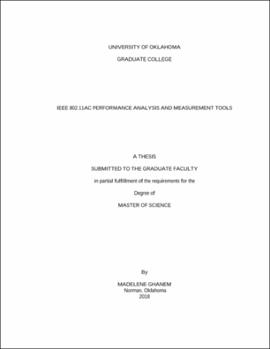| dc.contributor.advisor | Refai, Hazem | |
| dc.contributor.author | Ghanem, Madelene | |
| dc.date.accessioned | 2018-08-08T15:28:59Z | |
| dc.date.available | 2018-08-08T15:28:59Z | |
| dc.date.issued | 2018-08 | |
| dc.identifier.uri | https://hdl.handle.net/11244/301378 | |
| dc.description.abstract | Wireless local area networks have witnessed a large growth over the course of the last decade which has led to increased data traffic and demand for higher speeds. One of the IEEE 802.11 standards family that was developed to offer very high throughput WLANs is IEEE 802.11ac. Theoretically, with the PHY and MAC enhancements embedded in this standard, it is expected to provide gigabit-per-second data rates.
The WLAN standards in addition to other wireless technologies such as Bluetooth and ZigBee share the same unlicensed band, and the increase in the use of this band requires monitoring the wireless spectrum and addressing wireless coexistence problems via spectrum surveys which usually produce a large data volume, that requires advanced hardware capabilities to help overcome the challenges of storing, retrieving and processing the data.
This thesis reports on the performance analysis of an IEEE 802.11ac network with respect to varied channel conditions such as SNR and SIR. Mathematical models of the relationship between the throughput, the delay of the network and SNR using interpolation, were provided. The results show that for good channel conditions i.e. high SNR, 802.11ac offers high throughput values. However, the throughput is highly affected by the interference level caused by other 802.11ac devices that share the same channel, as the throughput of the under-test network is directly proportional to the level of SIR.
Moreover, this thesis details a measurement tool that implements a probabilistic efficient storage algorithm (PESA) proposed by Dr. Al-Kalaa with US FDA that could be used in deploying long-term spectrum surveys in the time-domain using LabVIEW. PESA algorithm is based on representing the dynamic range of a monitoring device by a Gaussian Mixture Model, establishing windows of activity and inactivity and mapping the windows to the Gaussian component with the largest responsibility for each window mean. The indexes of the Gaussian components are stored in addition to the count of samples in each window resulting in a significant storage volume reduction. The software was used to survey the 2.4 GHz band in a healthcare facility for 7 hours. The results show a reduction in the required storage size of approximately 98.8% while maintaining an accurate estimation of the channel utilization. | en_US |
| dc.language | en_US | en_US |
| dc.subject | WLAN, Empirical Modeling, Network Performance, Wireless Coexistence | en_US |
| dc.title | IEEE 802.11ac Performance Analysis and Measurement Tools | en_US |
| dc.contributor.committeeMember | Runolfsson, Thordur | |
| dc.contributor.committeeMember | Imran, Ali | |
| dc.date.manuscript | 2018-08 | |
| dc.thesis.degree | Master of Science | en_US |
| ou.group | College of Engineering::School of Electrical and Computer Engineering | en_US |
| shareok.orcid | 0000-0002-2566-2591 | en_US |
